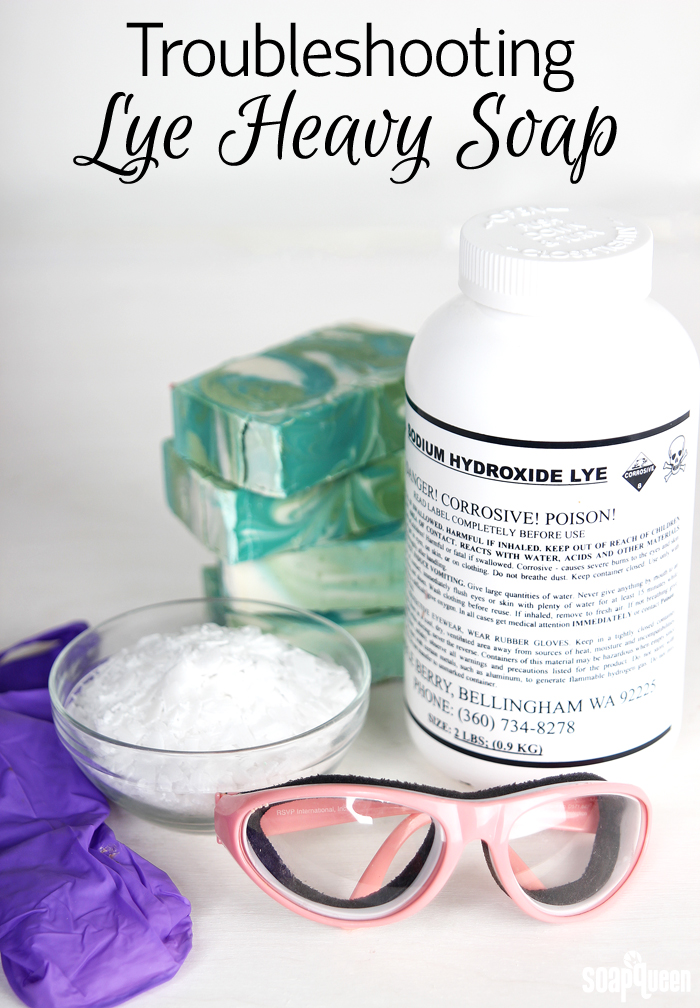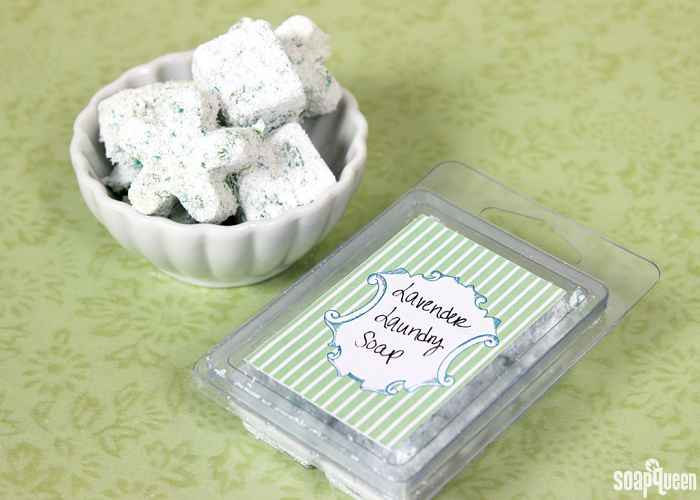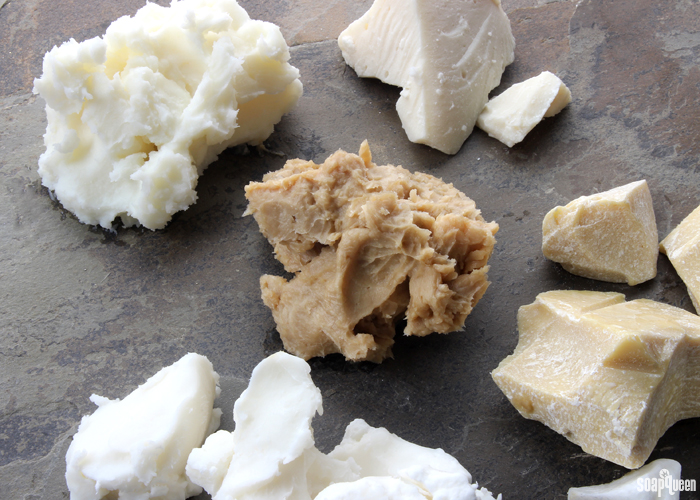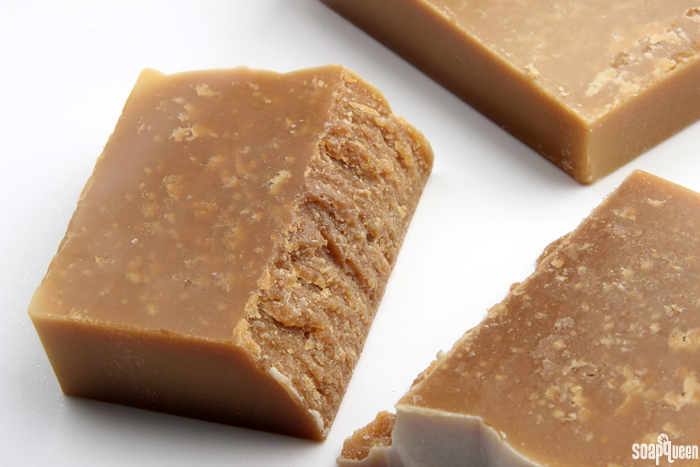
Preparing your work space before making cold process soap is essential. It helps the process run smoothly, as seen in this post. However, as any soaper can attest, even with the best planning you can forget something. Maybe it’s a colorant, a fragrance, or an oil. Trust me, it happens! Not that I’m speaking from experience or anything. 😉
While forgetting a color can change the design slightly, forgetting an oil can result in lye heavy soap that may burn your skin. The soap can also end up lye heavy if the recipe amounts are off, if the ingredients are mismeasured, if the scale isn’t functioning properly, etc. This creates a hard or brittle soap. It may also be irritating or drying to the touch, or have little white pockets that look like air bubbles. Testing the soap is the best way to know for sure.
How to test soap for lye heaviness
There are several ways to check if the soap is lye heavy. Before testing, wait five days. During the first two days, the lye is reacting with the oils and turning into soap. Most of the saponification process happens within those first two days. Allowing the soap to sit a couple extra days will ensure that process is complete and the results are accurate. The first test – the “zap test” – is nice and simple. It involves tapping the soap lightly on your tongue. It sounds weird, but it totally works. If it “zaps” you, it is likely lye heavy. The zap is hard to describe, but you will know it when you feel it. Do not the zap test if the soap is seeping, as the liquid may be unsaponified lye that can burn your tongue. If the soap doesn’t zap you, it is likely safe to use. You can use other methods to be sure though.
Did you know that red cabbage is an effective pH indicator? You can puree red cabbage with distilled water and drop the juice on the soap. If the soap is lye heavy, the soap will turn green or yellow. If it’s balanced, it will turn blue. Read more about using cabbage juice in this post.
 Cabbage juice can be used to test the pH level of soap. Learn how in this post.
Cabbage juice can be used to test the pH level of soap. Learn how in this post.
pH Strips are another way to see if the soap is lye heavy. To use them, wet the soap with water and rub your hands on it to form bubbles. Insert the test strip in the lather. Then, compare the color on the strip to the chart on the packaging. Normal soap pH is around 9-10. If the soap is 9-10 it will turn light green. If the soap is pH 11-14, it is lye heavy. The pH strip will turn a dark green or purple in that case.
 Normal soap pH is around 9-10. NOTE: This chart does not represent the colors on a pH strip.
Normal soap pH is around 9-10. NOTE: This chart does not represent the colors on a pH strip.
What to do if the soap is lye heavy
Don’t throw out your lye heavy soap! If the soap is slightly lye heavy (11-12 pH), it makes great laundry soap. Laundry soap is a combination of shredded soap and ingredients like baking soda and washing soda. The combination helps clean and deodorize dirty clothes. If the soap has a pH of 13-14, it may be a bit too harsh for delicates and works better for dirty rags, towels, etc. This post has three laundry soap options. The Natural Laundry Soap Recipe is made with soap, washing soda and citric acid. The post also features a recipe for natural dryer sheets made with white vinegar, lemon essential oil and lavender 40/42 essential oil.
 Lye heavy recipes can be used to make laundry soap.
Lye heavy recipes can be used to make laundry soap.
In certain cases, the soap may have pockets of lye. That typically happens when the soap separates. In that case, I recommend throwing the batch out to be extra safe. The lye pockets can irritate or burn the skin, or may do some odd things in the laundry.
If your soap is lye heavy and you would prefer to throw it out, handle with care. I would recommend wearing gloves when handling it, and double bagging it before throwing it out. If you’re considered with disposing of the soap, contact your local hazardous waste collection department.
What to do if the soap isn’t lye heavy
If the soap is 9-10 pH, it is safe to use on the skin. You may find the soap is 9-10 even if you forgot an oil. Along with adding a luxurious feeling to the soap, the superfat level can also act as insurance. For instance, if you forgot castor oil at 2%, a superfat level of 5% will cover that loss and the soap will still be balanced. Who doesn’t love a soapy backup plan?
If the soap is dry but not lye heavy, there may be something else going on. For instance, a high amount of butters in the recipe can make the soap firm or brittle. We recommend using them around 10-15% or less in the batch. Learn more in the All About Butters post. Too much sodium lactate can make the soap brittle as well. Sodium lactate is a liquid salt that helps the soap unmold more quickly. The usage rate is 1 teaspoon per pound of oils. If more than that is used, the soap may be a bit brittle. This post has more information on sodium lactate.
 A high percentage of butters can create hard bars. We recommend using them at 10-15% or less in your recipe.
A high percentage of butters can create hard bars. We recommend using them at 10-15% or less in your recipe.
Temperature can also affect the feel of the soap. If the soap gets really hot, it can crack, volcano, or form an odd texture called “alien brains.” It can also result in hard soap. Read more about how temperature affects soap here. To keep the soap cool, you can pop it in the fridge or freezer for 5-24 hours. This is recommended when using sugary additives like honey or fruit puree. The Adding Honey to Cold Process Soap post has more information on how to prevent overheating.
 This honey soap overheated and created a hard, dry bar.
This honey soap overheated and created a hard, dry bar.
If the soap is a bit too dry for your preference, it can be used as laundry soap. You can also rebatch the soap with equal or double parts of a soft recipe. Learn how to rebatch soap here. That will help balance the recipe and make it a bit softer. The Castile Rebatch is a great option because it’s soft and gentle on the skin.
If your batch separated but is not lye heavy, another option is the Hot Process Hero Method. It works for batches that have separated, seized, etc. The method involves pouring the batch into a stainless steel pot, stick blending it and heating it on the stove. That helps emulsify the soap fully. It works best within 24 hours, so if you see your batch separating the next day, give this method a try. The method helped emulsify this Black Cherry soap after it separated.
 The Hot Process Hero Method saved the Black Cherry Soap.
The Hot Process Hero Method saved the Black Cherry Soap.
